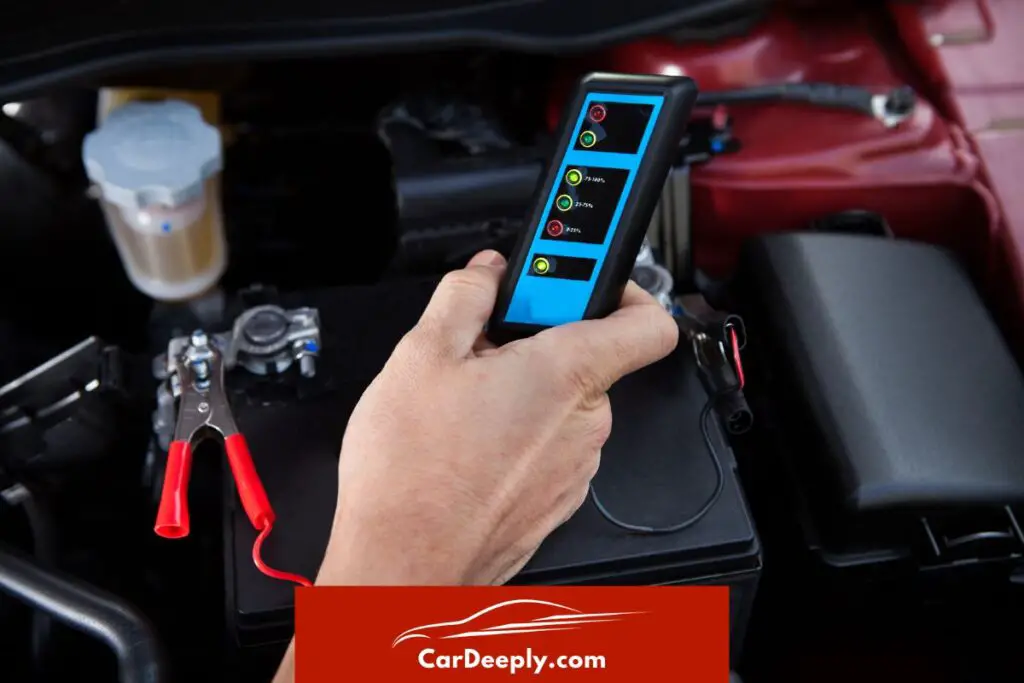Charging your car battery while parked can save you from unexpected breakdowns and costly repairs.
This article is your comprehensive guide to keeping your vehicle’s lifeblood healthy and ready for action. By reading on, you’ll avoid common mistakes and gain practical insights into the following:
- Using a portable charger
- Jump-starting your car
- Understanding the role of idling
So buckle up and get ready to dive into car battery maintenance. Your journey to becoming a car battery guru starts here!
Advertising links are marked with *. We receive a small commission on sales, nothing changes for you.
Key Takeaways

- Keeping your car battery charged prevents breakdowns and extends its lifespan.
- Car batteries work through a chemical reaction that produces electricity.
- Factors like parasitic drain and extreme temperatures can drain your battery.
- Charging methods include using a portable charger, jump-starting, idling, and battery tender.
- Regular maintenance can help prolong your car battery’s life and performance.
The Importance of Keeping Your Car Battery Charged
Your car battery is more than just a piece of equipment. It’s the heart of your vehicle, pumping energy to every part that needs it. But just like any heart, it must stay charged to keep your car running smoothly.
Here’s why:
- Prevents breakdowns: A well-charged battery ensures your car starts every time you turn the ignition.
- Saves money: Regular charging can extend your battery’s lifespan, saving you the cost of frequent replacements.
- Keeps other components healthy: Your car’s electrical components rely on a steady power supply from the battery.
So, keep your battery charged, and your car will thank you!
How Car Batteries Work
Have you ever wondered how your car battery works? It’s all about a chemical reaction.
Here’s a simplified explanation:
- The battery stores energy: Your car battery contains cells with lead and lead dioxide plates. These plates are immersed in a sulfuric acid solution.
- The chemical reaction begins: When you start your car, the sulfuric acid reacts with the lead plates, creating electricity.
- The electricity powers your car: This powers your car’s starter motor and other electrical systems.
In short, your car battery is a little chemical powerhouse!
Factors That Can Drain Your Car Battery
While car batteries are designed to be robust, certain factors can drain them faster than you’d like.
Here are some to watch out for:
- Parasitic drain: This happens when you leave your car’s electrical systems on while the engine is off.
- Extreme temperatures: Both hot and cold weather can affect your battery’s performance.
- Age: Over time, your battery’s ability to hold a charge will decrease.
By being aware of these factors, you can take steps to prevent premature battery drain and keep your car running smoothly. Remember, a little care goes a long way!
Using a Portable Car Battery Charger
You’re stuck in nowhere, and your car battery takes a nap. Frustrating, right? Don’t sweat it. You can quickly bring your battery back to life with a portable car battery charger.
Here’s how:
- Locate the battery terminals: Look for the red (+) and black (-) signs. These are your positive and negative terminals, respectively.
- Connect the charger: First, make sure your charger is off. Connect the positive lead from the charger to the positive terminal on your battery. Then, connect the negative lead to the negative terminal.
- Turn on the charger: Now, sit back and let it do its magic.
Remember, safety comes first! Always verify your charger is off before connecting it to avoid any nasty shocks.
Jump-Starting the Car
Sometimes, all your car battery needs is a jump-start.
Here’s a step-by-step guide:
- Locate the batteries: Find the battery in your car and the one in the functioning vehicle.
- Position the cars: Park the working vehicle close enough to yours so that the jumper cables can reach both batteries.
- Connect the cables: Attach one red clip to the positive terminal of the working battery and the other to the dead battery’s positive terminal. Then, connect one black clip to the working battery’s negative terminal and the other to an unpainted metal surface on your car.
- Start the engines: First, start the engine of the working car. Let it run for a few minutes, then try to start your vehicle.
Voila! Your car should be up and running again. But remember, this is a temporary fix. Make sure to get your battery checked as soon as possible.
Idling the Car: Pros and Cons
Idling your car to charge the battery can be a good alternative, but there are better options than this one. Here’s why:
- Pros: It’s easy and doesn’t require any special equipment.
- Cons: In newer cars, the battery won’t charge unless you’re at high RPMs, which won’t happen if the vehicle is idling.
While idling can help charge the battery in older cars, it might not be as effective in newer models. Consider your car’s specific needs before deciding on the best charging method.
Using a Battery Tender
A battery tender can be a lifesaver, especially if you don’t use your car frequently. It plugs into a standard AC outlet and transfers a small amount of power to your car battery to prevent it from discharging.
- Connect the tender: Like with the charger, connect the positive lead to the positive terminal and the negative lead to the negative terminal.
- Plug it in: Connect the battery tender to an AC outlet and let it do its job.
Remember, a battery tender is not a charger. It won’t charge a dead battery but will maintain a fully charged battery when the car is not in use.
How to Maintain Your Car Battery for Longevity
Taking care of your car battery can extend its life and save you money in the long run. Here are some tips:
- Regularly check your battery: Look for any signs of damage or corrosion.
- Please keep it clean: A dirty battery can discharge faster.
- Don’t let it idle for too long: An idle battery can slowly lose its charge.
By following these tips, you can ensure that your car battery stays healthy and is ready to power your vehicle whenever needed. So, remember these and give your car battery the care it deserves.
Frequently Asked Questions
Can I use a solar charger to charge my car battery while parked?
Absolutely!
Solar chargers are a great eco-friendly option for maintaining your car battery’s charge, especially if you park outdoors. They convert sunlight into electricity, which is then used to charge your battery. However, remember that the charging speed might be slower than traditional chargers.
How often should I charge my car battery to ensure longevity?
The frequency of charging depends on your car usage. If you use your car daily, the alternator should keep the battery charged. But if you leave your car parked for extended periods, it’s a good idea to charge the battery every two weeks to prevent it from discharging.
What’s the difference between a car battery charger and a jump starter?
A car battery charger slowly replenishes the charge in a battery over several hours, while a jump starter provides a quick burst of power to start a car with a dead battery. A charger is great for maintenance, while a jump starter is useful for emergencies.
Can a car battery be overcharged?
Yes, overcharging can damage a car battery. It can lead to overheating, which may cause the battery to swell or leak. Always follow the manufacturer’s instructions when charging your car battery to avoid overcharging.
How do I know if my car battery needs replacing?
Signs of a failing car battery include:
1. Difficulty starting the car.
2. Dim headlights.
3. A weak car horn.
4. The battery warning light on your dashboard.
If you notice these signs, it might be time to replace your battery.

Sebastian loves convertibles and drove a BMW 335i for a long time (325 hp is just a dream). Today, with two children, he is more concerned with SUVs and family-friendly vehicles. In addition to an Audi A4 Avant, he also drives a Cupra Formentor VZ – even as a family man, you can’t do without speed. Get to know Sebastian better and visit the About Us page.
Advertising links are marked with *. We receive a small commission on sales, nothing changes for you.

